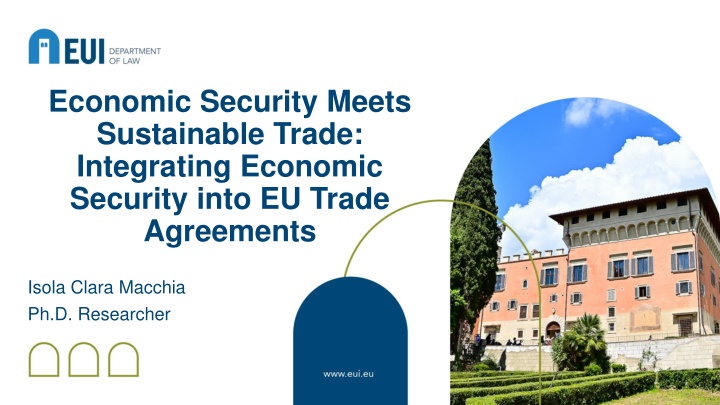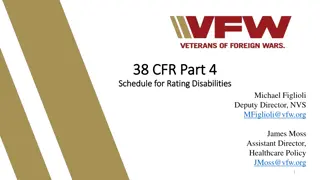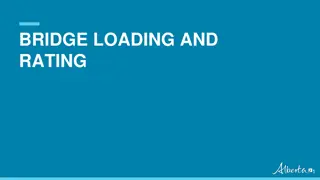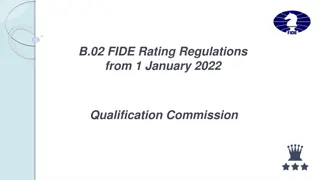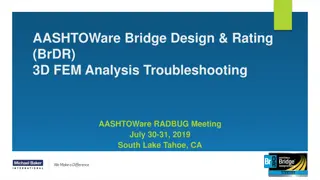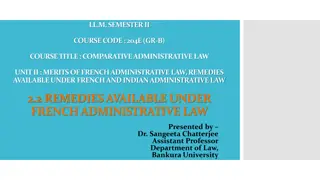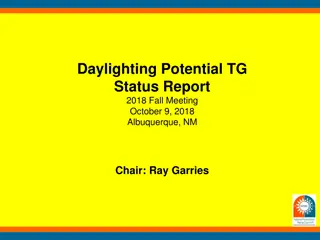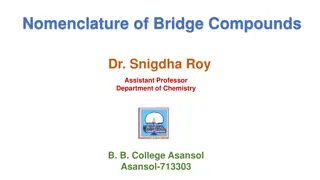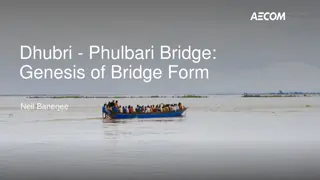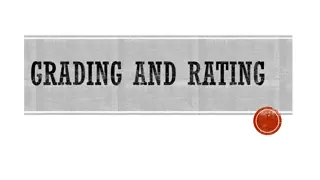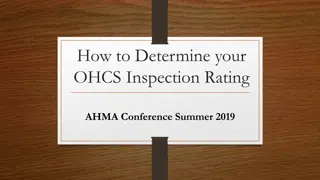Administrative Overview of Bridge Design and Rating 2014
This overview focuses on the administrative aspects of bridge design and rating in 2014, including revenue distribution, expenditures, and the use of AASHTOWare for management. It covers various aspects such as licensing, service units, professional services, and maintenance. The content delves into the structure, funding, and functionality related to bridge design and rating in the specified year.
Download Presentation

Please find below an Image/Link to download the presentation.
The content on the website is provided AS IS for your information and personal use only. It may not be sold, licensed, or shared on other websites without obtaining consent from the author.If you encounter any issues during the download, it is possible that the publisher has removed the file from their server.
You are allowed to download the files provided on this website for personal or commercial use, subject to the condition that they are used lawfully. All files are the property of their respective owners.
The content on the website is provided AS IS for your information and personal use only. It may not be sold, licensed, or shared on other websites without obtaining consent from the author.
E N D
Presentation Transcript
Economic Security Meets Sustainable Trade: Integrating Economic Security into EU Trade Agreements Isola Clara Macchia Ph.D. Researcher
Introduction 2020-2022: big economic shocks Growing security within EU (trade) policy focus on economic 2
What future for trade and sustainable development? Economic security vs sustainable development? Overview: 1. Trade policy and sustainable development after Lisbon 2. EU economic security strategy 2023 and 2024 3. Small case study: Sustainable Fisheries Partnership Agreements (SFPAs) 4. Conclusions 3
Trade policy & SD post-Lisbon Lisbon Treaty entered into force in 2009 a. Article 3(3): the EU shall work for the sustainable development of Europe based on a balanced economic growth [ ] aiming at full employment and social progress, and a high level of protectionand improvementof the quality of theenvironment b. Article 3(5): the EU in its relations with the wider world, [ ] shall uphold and promote its values and interests contributingto sustainable development, free and fair trade c. Article 21: the EU shall seek to develop relations and build partnerships with third countries, and international, regional or global organisations. [ ] It shall promote multilateral solutions to commonproblems Free Trade Agreements (FTAs) cornerstone of this approach + their TSD chapters 4
FTAs and TSD chapters Pre-Lisbon: some commitments on human rights since the 1990s First FTA post-Lisbon: 2011 EU-South Korea ILO ratification Multilateral environmental standards Obligations to not fail to effectively enforce environmental and labour standards Dedicated dispute settlement mechanism non-binding Civil society participation (DAGs, Civil Society Forum) Most recent and advanced: 2023 EU-New Zealand Expanded commitments (gender equality, indigenous rights, climate change, biodiversity) Binding dispute settlement for TSD disputes (compliance phase + sanctions) 5
EU economic security strategy /1 FTAs modernise old ones and diversify with new ones Raw Material Partnerships U.S. and India Trade and Technology Councils New clean-tech partnerships Moving on from FTAs? Fran ois Chimits and others, European Economic Security: Current Practices and Further Development (2024) EPRS. 6
EU economic security strategy /2 Sustainable development linked with economic security goals Raw materials criticality for EU supply chains EU DR and CSDDD supply chains tightly 7 Fran ois Chimits and others, European Economic Security: Current Practices and Further Development (2024) EPRS.
Move to new partnerships Smaller Sectoral focused on economic security priorities More flexible not same regulatory convergence as in FTAs What space for SD commitments? Moving on from TSD chapters? 8
Sustainable Fisheries Partnership Agreements (SFPAs) Secure access for EU vessels to fish for surplus stocks in the exclusive economic zone (EEZ) of third countries, they ensure equal rules, scientific management and social empowerment, with a focus on environmental sustainability, local growth, human rights and shared accountability. [ ] At the same time, a clause concerning respect for human rights has been included in all protocols to fisheries agreements Two types: tuna and mixed (different fish stocks) Way shorter than FTAs https://oceans-and-fisheries.ec.europa.eu/fisheries/international- agreements/sustainable-fisheries-partnership-agreements-sfpas_en 9
Madagascar (tuna) Greenland (mixed) SFPA Preamble Principles Cooperation and dialogue Exchange of information Joint Suspension organisations Joint Committee in charge of application, implementation, and dispute settlement determined to cooperate [ ] in securing sustainable fisheries [ ] and sustainable exploitation of marine living resources implement in accordance with ECHR and UN Declaration on the Rights of Indigenous People Breach of ECHR and UNDRIP commitments Greenland Scientific and technical cooperation employment of seamen in line with ILO Declaration of Fundamental Rights at Work resolved to pursue closer and more equitable economic and social cooperation [for ] sustainable fisheries employment of seamen under ILO rules and International Maritime Organisation Ibid. Ibid. Breach of human rights Madagascar Economic and social cooperation to encourage capacity-building in Madagascar for sustainable fishing 10
Key differences with FTAs and TSD chapters Pros Cons - More sectoral focus on sustainable development (SD capacity building in Madagascar fishing sector) - Dispute settlement procedures less developed in SFPAs than TSD chapter - Less institutional architecture (no TSD committee, no DAGs, no Civil Society Forum) - Suspension clause for HR - No suspension clause for SD (broader than HR) 11
Conclusion Potential contestation from CSOs Chance to define EU economic security more oriented towards sustainable development? 12
Thank you for your attention! Feedbacks and questions are highly welcome: isolaclara.macchia@eui.eu 13
